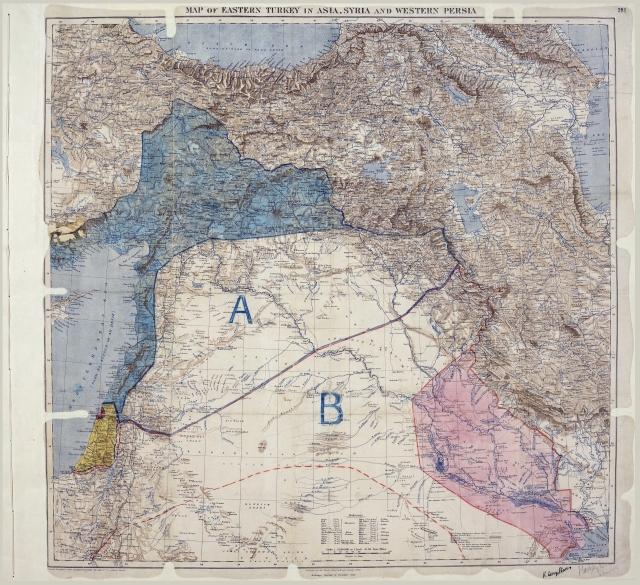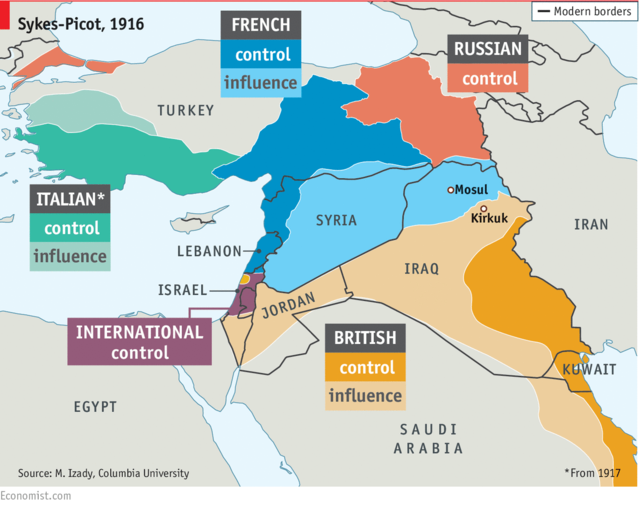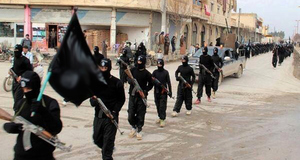A Colonial Catalyst: Reverberations of the Sykes-Picot Agreement in the Rise of ISIS
By
2016, Vol. 8 No. 11 | pg. 1/1
KEYWORDS:
The Islamic State of Iraq and Syria (more commonly known as “ISIS,” but also referred to as the “Islamic State of Iraq and the Levant” or simply “the Islamic State”) has been on a reign of terror in the Middle East for the past three years, and emerged seemingly out of nowhere. However, though its rise appeasr to be quite rapid and is often blamed on Islam or the Middle East itself, in reality, ISIS has its roots much deeper in history, as far back as the beginnings of Western colonialism and the fall of the Ottoman Empire, and the subsequent western affinity for questionable alliances. This is most clearly reflected through the direct and indirect aftermath of the Sykes-Picot Agreement, ISIS’s resulting ideological appeal, and its current messaging and recruiting tactics. First and foremost, to truly understand the impact of colonialism in the Middle East, one must look at the document that served as the foundation for western colonization in the region: the Sykes-Picot Agreement. The agreement, which was forged by both the British and the French - and briefly in conjunction with the Russian government as well, before its delegation had to pull out to focus on its dramatic internal revolution - tells a traditional and stereotypical tale of imperialism: Western governments arbitrarily drew lines dividing up the land forming the remains of the Ottoman Empire, ignoring traditional ethnic, religious, and tribal divisions. To add insult to injury, however, Sykes-Picot was double-crossed the Hashemites, who had been promised their own kingdom in return for helping the Western forces take down the Ottomans from the inside. Rather than becoming stewards of one of the greatest kingdoms the Middle East had ever seen, the Hashemites were instead thrown out of Syria, the new French protectorate (Mallon, 2016). In the words of one historiam, the agreement was “greed allied to suspicion and so leading to stupidity” (Unintended Consequences, 2016). "While the exact circumstances that have led to the rise of ISIS are the result of recent events, the climate that fostered the creation of such a group was abetted by western interventionism since the fall of the Ottoman Empire." Double-crossing aside, the results of this arbitrary division were devastating. One only has to look at the Sykes-Picot Agreement’s effects on Iraq to see just how long-lasting the consequences were. The country, which has become a current hot-bed for ISIS, was the result of bringing together three completely different groups when combining the cities of Mosul, Basra, and Baghdad. These tribes had little to no shared history - and yet they were expected to overlook their conflicting ideologies and coalesce as one unified base to form a functional country (Mallon, 2016). This - the overarching spirit of Sykes-Picot - manifested itself instead in complete and utter chaos and decades of resentment, not just between the Arabs and the Western powers, but within the Arab states themselves.Top: An original map showing regions of Eastern Turkey, Syria, and Western Persia partioned by the French and the British, signed by Mark Sykes and François Georges-Picot circa May 1916. Bottom: A more modern rendering showing the different realms of influence and control. Image © The Economist. As a result, it has become very easy for groups like ISIS to prey on this sentiment, particularly when it comes to recruiting new members. The resentment arbitrary groupings brought about by agreements such as Sykes-Picot played into the hands of anti-western ideologues within the Muslim community, such as Sayyid Qutb, who served as one of the greatest inspirations for both Osama Bin Laden and eventually, Abu Bakr Al-Baghdadi, the current leader of ISIS (Kirkpatrick, 2014). While Qutb and Bin Laden used imperialism as a justification for jihad, Al-Baghdadi took it a step further, specifically calling out Sykes-Picot as an example of the “conspiracy” of those whom ISIS considered infidels. In the middle of the rapid rise of ISIS in 2014, when everyone’s attention was turned towards ISIS’s actions in Syria and horrific beheadings of western journalists, Al-Baghdadi gave a speech that has been received with an understated response thus far, but needs to be further examined to truly understand the inner-workings of the mind of these “jihadists.” Standing at Mosul’s Great Mosque of al-Nuri, Al-Baghdadi declared, “This blessed advance will not stop until we hit the last nail in the coffin of the Sykes–Picot conspiracy.” (McGrath, 2014). Another sleek ISIS propaganda video was also released, titled Kaser al-Hudud - the Breaking of the Borders - claiming that “This is not the first border we will break. Inshallah, we break other borders also, but we start with this one.” (Tinsley, 2015). Of course, it could be argued that this entire argument is far too simplistic, and that ISIS’s accusations of Sykes-Picot as a western conspiracy and that the agreement fostered hateful sentiment by lumping together different ethnic groups is a weak argument as it relies too much on the falsely assumed validity of primordialism. After all, as Stephen Kinzer pointed out in The Boston Globe, it is not as though all former colonies have problems with rampant terrorism, either; Congo, Mozambique, and Angola were all brutally colonized by Belgium and Portugal respectively, but none of these countries have produced terrorist groups as brutal or single-mindedly fixated on revenge for colonization as ISIS (Kinzer, 2014). However, while the primordial argument is categorically untrue when it comes to race and ethnicity, it does have some validity when it comes to sectarianism - for while intrinsic, biological hatred may not be a realistic argument, the ancient hatred that stems from leaders who fuel the flames of sectarianism has been around for centuries. And today, ISIS takes full advantage of it. This seems a bit counterintuitive at first - after all, if one of the main problems with Sykes-Picot was that it arbitrarily created borders and grouped tribes with differing histories together, how is ISIS’s mission of taking down these borders and trying to unite all of these groups under one Islamic State any less problematic logistically? The key here again is the difference in how the framers of Sykes-Picot and ISIS view sectarianism. While the architects of the agreement were blind to these divisions, ISIS - fueled by the aforementioned centuries of resentment that were fostered by Sykes-Picot - seeks to destroy these divisions by slaughtering religious minorities and establishing a specifically Sunni caliphate (Phillips, 2014). The group’s role in Iraq and Syria best solidifies this argument. In the case of Iraq, for example, after being persecuted by Saddam Hussein’s Sunni administration, Prime Minister Nouri Al-Maliki and his Shia government in turn persecuted Sunnis in the post-war period by imprisoning Sunni opposition protesters and preventing any former Hussein-era administrators from holding office, effectively shutting out Sunnis from power and leading to waves of Sunni anger (Cairo, 2014). ISIS easily exploited this anger, before turning its eyes to Syria, where it also took advantage of unhappiness with authoritarian regimes (Beauchamp, 2014). Specifically, fighters entered into rural Syria almost immediately after it became clear that the country was falling into a state of drawn-out civil war. Given that most of the Syrians thought the fighters were entering the country to help the Free Syrian Army (FSA) and the other opposition fighters liberate the country from the grip of Bashar al-Assad’s Shia regime, the ISIS fighters were originally welcomed with open arms. This allowed the terrorist group to set up healthcare clinics, neighborhood watches, tax-collection services, children’s centers, and other institutions and thereby brainwash the vulnerable Syrian population into supporting the concept of a seemingly stable Islamic State, which subsequently allowed ISIS to move rapidly towards urban locations in the country as well (Beauchamp, 2014). However, ISIS soon began first excluding Shiites and other religious minorities such as the Kurds from these services, and then shifting to violent tactics, killing members of the FSA and seizing Raqqa by subduing and executing the locals - then posting the videos to YouTube to scare anyone else who would dare defy them (Taleb, 2014). In this way, it could be argued that the Arab Spring was the real catalyst for the rise of ISIS. After all, the power vacuums that arose from toppled dictators and civil wars were the only reason ISIS had a space or opportunity to come to power in the first place. However, if this is the case, one also has to ask why and how so many authoritarian regimes were allowed to perpetuate for so long in the first place. The answer again comes back to Sykes-Picot. As journalist Fareed Zakaria noted in an analysis of the region, the only way the countries arbitrarily formed by Sykes-Picot were able to function was through a system of dictatorships or authoritarian rule that suppressed the dissenting masses. Further, in addition to the governments of these newly formed countries receiving external support from the British, French - eventually the Americans and the rest of the western world as well - at their conception, the governments continued to be upheld by these external forces in the decades that followed. This resulted in the authoritarian regimes focusing more on taking what action was necessary to maintain western support rather than taking what action was necessary to help their own people (McGrath, 2014). As political scientist Wendy Pearlman asserts, this constant state of oppression and neglect by the regimes led to a unique set of emotions that was one of the factors that eventually led to the Arab Spring itself, and the resulting power vacuums (Pearlman, 2013). Tracing this arc backwards we thus see that while the Arab Spring was a direct catalyst, the wave of revolution itself is still rooted in colonialism. There are other holes in this argument as well, however - for example, not all fighters for ISIS are Arabs who have lived directly in the aftermath of Sykes-Picot’s instability. Narratives such as Michael Muhammad Knight’s - a former member of ISIS who left America to join the fight - show that western ideologies are actually drawing people to ISIS, despite the fact that ISIS predicates itself on anti-western sentiment. As Knight wrote in an essay about his experiences with the terrorist group, he was originally attracted to the group for its messaging of liberating the oppressed. “Whenever I hear of an American who flies across the globe to throw himself into freedom struggles that are not his own,” he wrote, “I think, ‘what a very, very American thing to do.’” (Knight, 2014). Knight’s case, however, while not singular, is still unique. The majority of foreign fighters speak of experiencing a sense of alienation in their lives in the western world. As Loretta Bass of the University of Oklahoma found in her studies (2014), a deep sense of marginalization exists in many young Muslims in the West in particular, due largely to rampant xenophobia and discriminatory laws that not only prohibit practices like wearing the hijab, but also prevent these working-age Muslims from finding employment and improving their general financial status. ISIS has been taking advantage of this with its marketing, declaring that this inequality is a result of the dominance of the west over the world since the fall of the Ottoman Empire, the last Islamic empire (Tinsley, 2015). For example, the terrorist group has posted several videos calling on these young Muslims and offering them not just a physical free home with electricity and water, but an emotional one as well. Given the dismal conditions both materially and psychologically that these Muslims face in the west, coupled with their constant state of being, as anthropologist Scott Atran describes, “bored, underemployed, overqualified, and underwhelmed,” it is no wonder that they are so vulnerable to these promises (Hasan, 2014). Further, it appears that this historically rooted sense of alienation affects all genders equally. For instance, female “jihadis” come from countries that have ostracized them, and from those which have banned them from fully carrying out their religious practices. For example, countries like France have banned the wearing of the veil; as a result, an overwhelming roughly 20% of ISIS’s foreign female recruits are from France. Moreover, these women then become recruiting machines for ISIS themselves, posting blogs about their allegedly much-improved daily lives; Aqsa Mahmood, an ISIS fighter originally from Sweden, for example, is credited with writing the posts that were what allegedly drove three British schoolgirls to flee to Syria to join the movement in February 2015 (Mahmood, 2014). The emphasis on a lack of borders and nationalism within other ISIS recruiting materials also stands in sharp contrast to Sykes-Picot’s overall sentiment. Whereas joining Al-Nusra - the Syrian Al-Qaeda off-shoot - requires knowledge of Arabic to join, ISIS is able to widen its pool of potential recruits by eliminating such a requirement (Weaver, 2015). Even Dabiq, ISIS’s online magazine, is in English - a choice that is instrumental to deracializing and denationalizing the religious mission of the group as both Islam and Islamic fundamentalism have traditionally been conflated in broader society with Arabic language and culture. Politically, Dabiq also reflects an anti-colonial emphasis as it publishes otherwise underreported statistics that paint the West in a negative light, such as the number of women and children who American drone strikes have killed, as opposed to religious ideologies and crude instructional demonstrations of tactics such as how to make a simple bomb - an article that frequently made an appearance in Al-Qaeda’s publications (Zakaria, 2014). Over all, having examined ISIS’s colonial roots as well as both its historical and ideological appeals and how they tie into the group’s incredibly effective call to arms, it becomes clear that while the exact circumstances that have led to the rise of ISIS are the result of recent events, the climate that fostered the creation of such a group was abetted by western interventionism since the fall of the Ottoman Empire. Further, while ISIS itself has been extremely successful due to its unusually effective recruiting strategies, the anti-colonial ideology it espouses is far from unique. Gertrude Bell, one of the British architects behind the Sykes-Picot Agreement once said, “I’ll never engage in creating kings again; it’s too great a strain” (Kinzer, 2014). Though she was speaking from a personal standpoint, she did not live to see just how much of a strain the imperialism of her compatriots and herself truly had on the global level - but one can only hope others will observe these patterns of history and learn from these excruciatingly devastating mistakes of the past. ReferencesBass, L. (2014, November 20). What Motivates European Youth to Join ISIS? Retrieved May 22, 2016, fromhttp://www.joshualandis.com/blog/push-factors-helping-isil-recruitment-loretta-bass/ Beauchamp, Z. (2014, August 22). Myth #1: ISIS is crazy and irrational. Retrieved May 20, 2016, from http://www.vox.com/cards/isis-myths-iraq/crazy-irrational Cairo, & Erbil. (2014, June 21). How did it come to this? Retrieved May 21, 2016, from http://www.economist.com/news/middle-east-and-africa/21604627-crisis-iraq-has-roots-going-far-back-history-recently-folly Hasan, M. (2014, August 21). What the jihadists who bought "Islam for Dummies" on Amazon tell us about radicalisation. Retrieved May 20, 2016, from http://www.newstatesman.com/religion/2014/08/what-jihadists-who-bought-islam-dummies-amazon-tell-us-about-radicalisation Kinzer, S. (2015, January 18). Terrorism in Paris, Sydney the legacy of colonial blunders - The Boston Globe. Retrieved May 22, 2016, from http://www.bostonglobe.com/opinion/2015/01/18/terrorism-paris-sydney-legacy-colonial-blunders/oEY5qPo1uGRIZDC8UfNEyH/story.html Kirkpatrick, D. D. (2014, September 24). ISIS’ Harsh Brand of Islam Is Rooted in Austere Saudi Creed. Retrieved May 23, 2016, from http://www.nytimes.com/2014/09/25/world/middleeast/isis-abu-bakr-baghdadi-caliph-wahhabi.html?_r=0 Knight, M. (2014, September 3). I understand why Westerners are joining jihadi movements like ISIS. I was almost one of them. Retrieved May 24, 2016, from http://www.washingtonpost.com/posteverything/wp/2014/09/03/i-understand-why-westerners-are-joining-the-islamic-state-i-was-almost-one-of-them/ Lister, C. (2014, December 1). Profiling the Islamic State. Retrieved May 24, 2016, from http://www.brookings.edu/research/reports2/2014/12/profiling-islamic-state-lister Mahmood, A. (2014, April 19). Diary of a Muhajirah. Retrieved May 22, 2016, from http://fa-tubalilghuraba.tumblr.com/post/82181535227/diary-of-a-muhajirah Mallon, E. D. (2016, May 17). Colonial Creations. Retrieved May 24, 2016, from http://americamagazine.org/issue/colonial-creations McGrath, T. (2014, July 02). Watch this English-speaking ISIS fighter explain how a 98-year-old colonial map created today’s conflict. Retrieved May 23, 2016, from http://www.dailynews.com/general-news/20140702/watch-this-english-speaking-isis-fighter-explain-how-a-98-year-old-colonial-map-created-todays-conflict Phillips, D. L. (2014, July 08). Extremists in Iraq need a history lesson: Phillips. Retrieved May 20, 2016, from http://www.cnbc.com/2014/07/08/what-isis-can-learn-from-historyiraqmiddle-eastcommentary.html Taleb, J. (2014, August 22). From Assad to ISIS, a tale of Syrian resistance - Waging Nonviolence. Retrieved May 23, 2016, fromhttp://wagingnonviolence.org/feature/assad-isis-tale-resistance/ Tinsley, M. (2015, April 23). ISIS’s Aversion to Sykes-Picot Tells Us Much About the Group’s Future Plans. Retrieved May 22, 2016, from http://muftah.org/the-sykes-picot-agreement-isis/#.V0Xwn_kwiUm Unintended consequences. (2016, May 14). Retrieved May 22, 2016, from http://www.economist.com/news/special-report/21698442-sykes-picot-carve-up-led-century-turbulence-unintended-consequences Weaver, M. (2015, April 18). Her Majesty’s Jihadists. Retrieved May 23, 2016, from http://www.nytimes.com/2015/04/19/magazine/her-majestys-jihadists.html Zakaria, R. (2014, November 18). OPINION: Behind the barbarism: Misreading online militant magazines. Retrieved May 20, 2016, from http://america.aljazeera.com/opinions/2014/11/militant-magazinespublishingisilalqaedapakistantaliban.html Suggested Reading from Inquiries Journal
Inquiries Journal provides undergraduate and graduate students around the world a platform for the wide dissemination of academic work over a range of core disciplines. Representing the work of students from hundreds of institutions around the globe, Inquiries Journal's large database of academic articles is completely free. Learn more | Blog | Submit Latest in History |




















